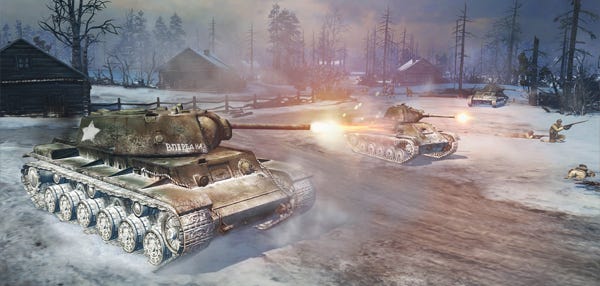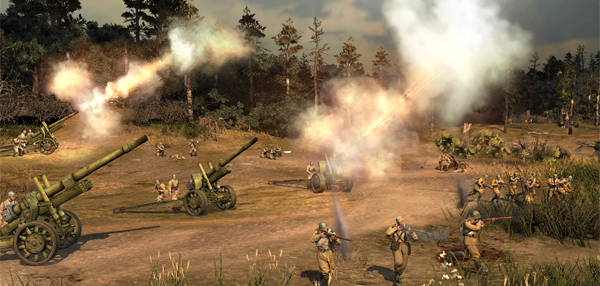Hands On: Company Of Heroes 2
Eastward ho!
Last week I got to sit down and make my hands do things in Relic's next strategy game, the Eastern Front-set World War II war of men that is Company of Heroes 2. While previously we've been shown frozen landscapes with dramatic new snow effects, this time I got thrown into the mud.
I was in a war, you know. A big war, with explosions and tanks and dug-outs and men with flamethrowers and men with mortars and men with machine guns and men with rocket-propelled grenades. It was awful. So I'm only too happy to go back to it.
In my couple of hours with Company of Heroes 2, I swiftly established that it is very much the sequel to Company of Heroes. Perhaps more so than I'd been expecting, given the action-RPG stylings of Dawn of War 2 was a sharp turn to the left from Dawn of War 1's tried and tested real-time strategising. Company of Heroes is Real War though, so a careful sticking to strategic roots is to be expected.
I got my arse kicked AND I LIKED IT. I didn't get my arse kicked because I didn't second-guess scripting correctly or because I didn't click quickly enough, but because I didn't plan and strategise and adapt well enough. Partly this was because I was dropped into large map with a implacable and heavily-armed foe (seriously, their 0-world of tanks speed was frightening) and my Company of Heroes-fu was embarrassingly rusty after several years away and partly because COH2 really doesn't seem to be taking any prisoners.
The essential setup was familiar - Russians v Germans in a push-and-pull battle for capture points across a sizeable map. In this case, that map was the Pripyat river - a name that rings calming bells for STALKER fans but in this 1940s-set case meant a traditional mud'n'vegetation World War II aesthetic, rather than the icy climes of COH2's weather-centric reveals to date. The most noticeable change, other than a general increase in spectacle and brutality, was that capture points were no longer locked to munition or fuel generation. Instead, my Engineers could place a structure on top of each one that would define which resource it generated.
This helped, once I'd got the knack of things again, to specialise my forces, and spared me from a few situations where I was locked out of building something particular because I didn't have enough of point x. Instead, I could adapt my hand to suit. This pleases me. I presume it's part of a broader move to slightly StarCraft-style specialist build strategies rather than a traditional climb up the the tech tree, too.
Something else that stood out was a slight touch of new persistency within maps. Certain vehicles and artillery aren't necessarily destroyed when they're taken out - instead, if you can get some infantry over there quick enough they can take control of the downed armour and get it back in the game. If you can plan and safely execute such a reclamation, you're potentially saving yourself a ton of resources and putting the willies right up the enemy when, say, an anti-tank gun suddenly comes back to life right in front of their best tank. It's a little bit Men of War and I am totally behind that.
For all that, I perhaps didn't feel the sense of freshness I was hoping for from a developer that's long been unafraid to make sweeping changes to its strategy stylings and it means COH2 is currently sat in the mental draw marked 'more of a good thing, writ a little larger' rather than 'ooh, I need to know more nownownow!' Then again I was dropped in cold into one map, so bigger picture stuff is unknown to me for now.
That said, I didn't get to experience the new 'Seasonal Warfare' feature which alters the nature of maps and even sees units don new togs to suit the climate. I'm Captain Impassive when told that historically authentic uniforms and camoflague will be included to reflect whichever season a battle takes place in, but I'm sure that's the kind of thing that provokes proud salutes from those who demand ever-more attention to detail from their wargames.
The environmental changes, however, are much more titillating to me. A map bifurcated by an impassable river in a sunnier season would instead see that body of water becoming a frozen thoroughfare in the midst of Winter. Back in Summer, the map becomes a tight war for control of choke points as well as of capture nodes. I like the idea that this could preclude the 'oh, that map again' in skirmish and multiplayer, and instead there'll be a need for an on-the-fly change of tactics and builds dependent on the climate you're faced with.
The general focus on weather and its effects do seem to have resulted in a game that's more about careful, tactically-important under-the-hood changes than sweeping ones, and for that reason I do wonder if COH2 will prove to be the slow-burn smash hit that COH1 was. The existing community will go nuts for it, I'm quite sure - there'll be a lot of new things to master, even if the initial learning isn't too far departed from the last three Company of Heroes games.
It's probably the right decision even if, as is probably all too evident from this piece, it rather complicates writing about the game from a broad-strokes preview perspective. In an age where strategy has seeming fled to the extremes of MOBAs' lanes and StarCraft II's leagues, the purity of COH2's warfare is more than welcome.
Also Engineers with flamethrower upgrades are still the most frightening thing.













